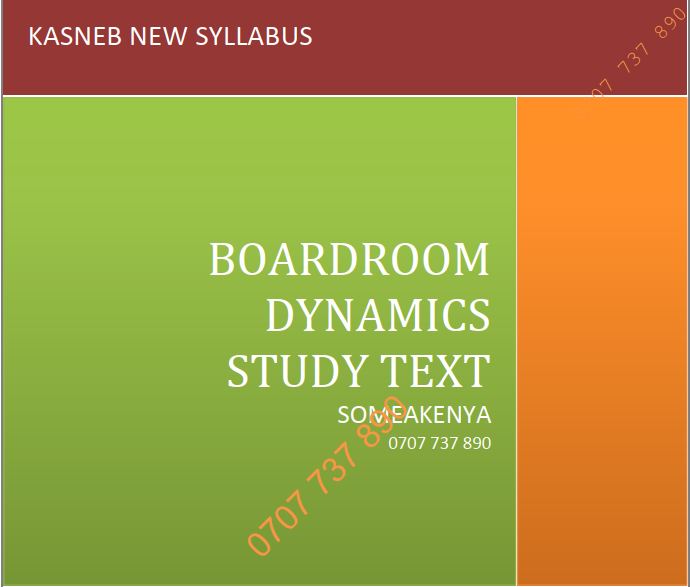
SomeaKenya provides Updated and Revised notes for the current CPA syllabus. Revision kits (Past papers with answers) are also available to help you with revision of the upcoming exams. you can get these materials in Hardcopies (Printed and Binded) and also Softcopies through Our mobile application which can be downloaded at Playstore.
Topics covered
1. The emergence of boardroom dynamics in corporate governance
1.1 Defining boardroom dynamics
1.2 The evolving focus on corporate governance
1.3 The three phases of board evolution
1.3.1 Ceremonial board
1.3.2 Liberated board
1.3.3 Progressive board
1.4 Building blocks of a progressive board
1.4.1 Group dynamics
1.4.2 Information Architecture
1.4.3 Focus on substantive issues
1.5 Impact of boardroom dynamics on organisational performance
1.6 Interest in human factors (human resources, management of talent, organisational culture, politics etc.)
1.7 Shifts in approaches to leadership
1.8 Focus on ethics
1.9 A broader model for corporate governance
1.10 Organisational failures and impacts on boardroom dynamics
1.11 Role of the corporate secretary in Board room dynamics
2. Evolution of Codes of Corporate Governance
2.1 Evolution of codes – global trends
2.2 Incorporation of boardroom dynamics in codes of corporate governance
2.3 Impact of codes of governance on board culture, behaviors and effectiveness
2.4 Evaluating human capital
2.5 Self-regulation in corporate governance
3. Governance Structures
3.1 Governance theories related to board structure
3.2 Board Structures: Unitary and two tier Boards
3.3 Components of governance structures
3.4 Board size
3.5 Committee structure
3.6 Director considerations
3.7 Best practices when creating and implementing governance structures
3.8 Evaluating governance structures in organisations
4. Skills, Competencies and Diversity of the Board
4.1 Human capital aspects of the board
4.1.1 Director competencies
4.1.2 Director skills and experience
4.1.3 Evaluating individual board members
4.2 Personal characteristics of the board.
4.3 Defining and understanding the measuring of diversity
4.4 Types of diversity
4.5 Areas of diversity and their relationship to boards
4.6 Diversity thinking in a boardroom setting
5. Understanding Boardroom Dynamics
5.1 Psychology of the board
5.1.1 The importance of board dynamics relative to board structure, demographics and attributes.
5.1.2 Psychological theories underpinning board dynamics
5.1.3 Characteristics of boards and board meetings
5.1.4 Board team processes
5.1.5 Board team outcomes
5.2 Individual and team resilience
5.3 Well- being and resilience of the board
5.4 Developing behavioral agility
6. Board Decision Making
6.1 Decision making as a core competence of a board
6.2 Evidence-based decision making
6.3 Cognitive bias
6.4 Individual differences in relation to decision making
6.5 Decision making tools
6.6 Board team decision making: Key factors and tools
7. Stakeholder Conversations
7.1 Developing dialogue over debate
7.2 Building trust through adult/adult conversations
7.3 The systems inside the board
7.4 The systems outside the board
7.5 Emotional intelligence as a core board competence
7.6 Managing conflict
7.7 Stakeholder communication
8. Culture in the Boardroom
8.1 Governance and culture
8.2 Defining board culture
8.3 Board culture dynamics
8.4 Application of Schein’s Three Levels of Culture model
8.5 Company culture
8.6 Country culture – Hofstede’s Cultural Dimensions
9. Board Diversity
9.1 Understanding diversity
9.2 Types of Diversity
9.3 Influences of board diversity (culture, law
9.4 Promoting diversity within the board
10. The Effect of Meeting Design on Boardroom Dynamics
10.1 Introduction to meeting design
10.2 Design of board meetings
10.3 Physical characteristics
10.4 Attendee characteristics
10.5 Trends in technology
10.6 Use of virtual boards for remote teams
10.7 Face-to-face versus virtual/audio interaction
11. The Role of the Governance Professional in Influencing the Boardroom Dynamics
11.1 The 21st Century governance professional
11.2 The strategic role of the corporate secretary
11.3 Application of theory
11.4 Influencing dynamics in a positive way
11.5 Leadership influence
11.6 Ethical dilemmas
12. Effective Talent Management
12.1 Board talent management overview
12.2 Skills and competencies of board members
12.3 Recruitment of board members
12.4 Introduction of board members
12.5 Board learning and development
12.6 Performance management of board members
12.7 The role of the corporate secretary/ governance professional in effective talent management
12.8 Ethical dilemmas in relation to managing talent
13. Board Evaluation
13.1 Methods and processes options of board evaluation
13.2 Evaluating director personal characteristics
13.3 Evaluating board dynamics
13.4 The corporate secretary as a board consultant
14. Power and Politics in Organisations
14.1 The art and science of power in organisations
14.2 Sources of power in organisations
14.3 Power and influence.
14.4 Managing change through power.
14.5 Leading with power.
15. Contemporary Issues and Case Studies in Boardroom Dynamics